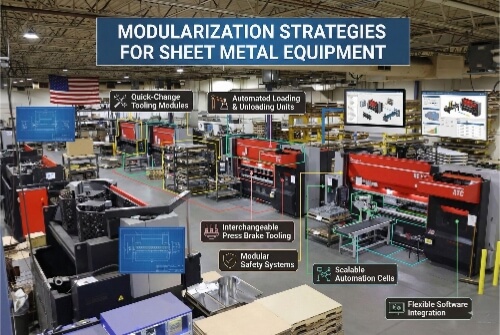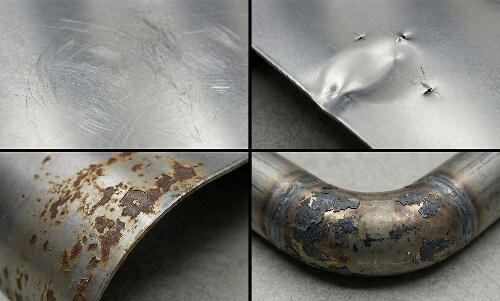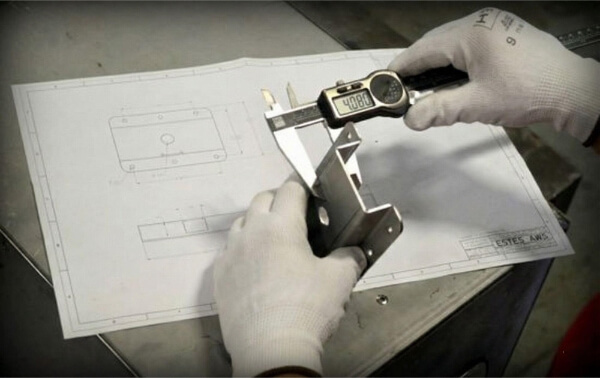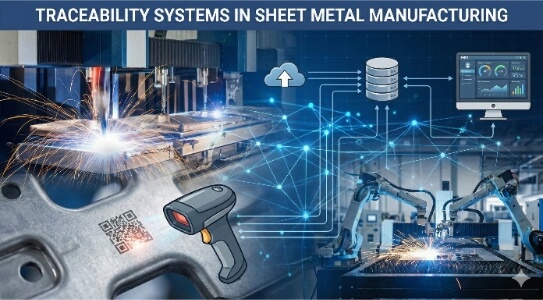Many manufacturers face bottlenecks when shaping metal parts. Traditional methods can waste time and limit design flexibility. This is where a punch press becomes a game changer. It speeds up production, ensures precision, and handles many tasks with just one machine.
Curious about how each type works and where they’re used? Keep reading to see how punch presses help industries run faster and smarter.
What Is a Punch Press?
A punch press is a machine used to cut, bend, or form sheet metal. It uses a tool called a punch to press the metal into a die. The metal takes the shape of the die after being hit by the punch. The machine can create holes, cutouts, flanges, or bends. It is widely used in industries that need metal parts in specific shapes.
The basic working principle is simple. The machine pushes a punch with high force into a sheet of metal placed over a die. The punch presses the metal into the die, cutting or shaping it.
The force can come from mechanical, hydraulic, or servo systems. The punch moves down in a straight line, hits the sheet, and returns to the starting position. Each cycle is quick. Some presses complete one cycle in less than a second. This makes them useful for mass production.
Key Components of a Punch Press Machine
A punch press has several main parts:
- Frame: The structure that holds the machine together. It must be strong enough to handle the high force.
- Ram: The moving part that drives the punch into the metal.
- Punch: The tool that shapes or cuts the metal.
- Die: The part that sits below the metal and shapes it from the other side.
- Bolster Plate: The flat plate that holds the die in place.
- Clutch and Flywheel (mechanical types): Store and release energy to move the ram.
- Hydraulic Cylinder (hydraulic types): Uses fluid pressure to drive the ram.
How does a punch press work?
A punch press works by using a punch and a die to shape sheet metal. Here’s how the process happens step by step:
- The metal sheet is placed on the die, which holds the shape that needs to be formed or cut.
- The punch is attached to a moving ram above the metal.
- When activated, the machine pushes the punch down with force.
- The punch presses the metal into the die. This can cut a hole, bend a flange, or form a specific shape.
- After the stroke, the ram pulls the punch back up, and the part is either removed or moved forward for the next step.
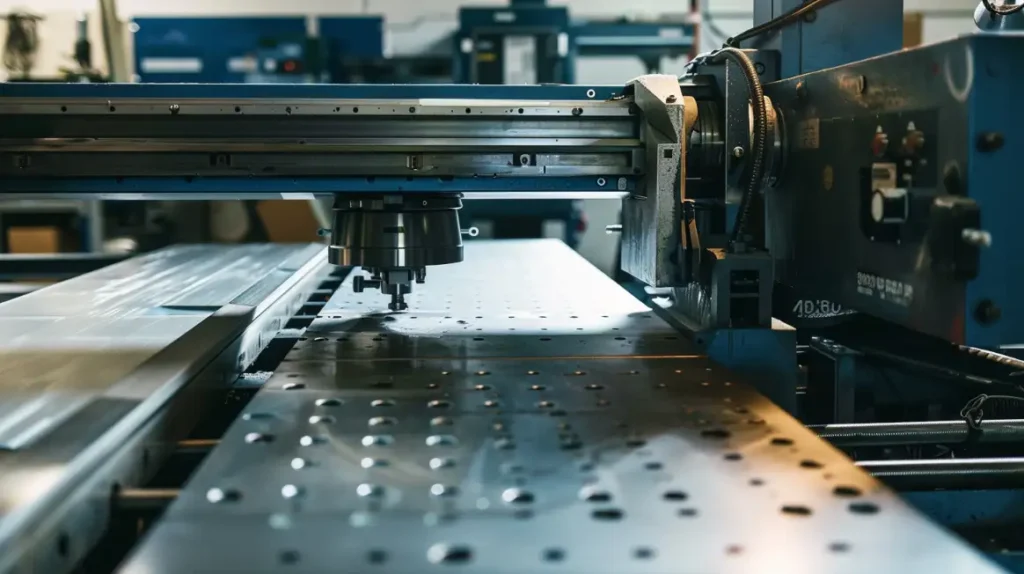
Major Types of Punch Press Machines
Punch presses are grouped by how they deliver force to the punch. Each type has its strengths. Choosing the right one depends on your production needs, part shapes, and material types.
Mechanical Punch Press
An electric motor powers the mechanical punch press and converts rotational motion into linear motion. This conversion powers the punching action. Mechanical punch presses have a high speed and are highly efficient for large production runs.
Flywheel-Driven Systems
The flywheel stores energy from an electric motor. When the clutch engages, it releases this energy to move the crankshaft. This drives the ram and the punch down.
The flywheel keeps spinning, so the machine can repeat strokes quickly. This makes mechanical presses ideal for stamping simple parts in large numbers.
Crankshaft Mechanism
The crankshaft converts the rotary motion of the flywheel into vertical motion. It moves the ram along a fixed path. This movement is fast and consistent.
The crank system is durable but has limits. It cannot easily change stroke speed or force mid-cycle. This makes it less suitable for complex shapes or thick materials.
Hydraulic Punch Press
Hydraulic presses use fluid power instead of a flywheel. They offer smooth, steady force through the whole stroke. This makes them good for thicker materials or complex forming.
Pressure Control and Fluid Mechanics
A hydraulic pump pushes oil into a cylinder. The pressure moves a piston, which drives the ram and punch down.
The pressure can be adjusted. This lets operators control the force precisely. The system works at a slower pace than mechanical types, but it’s more flexible.
Benefits of Hydraulic Operation
Hydraulic presses apply full tonnage through the entire stroke. This helps when forming deep shapes or bending thick materials.
They are quieter and easier to adjust. They also produce less vibration, which can improve part quality and machine life.
Hydraulic systems need regular maintenance. Fluid levels and seals must be checked to avoid leaks or pressure loss.
Servo-Electric Punch Press
Electric motors power servo-electric presses. They use belts or ball screws to move the ram. These machines are the newest type and offer many modern advantages.
Energy-Efficient Features
Servo systems use energy only when the ram moves. This makes them more efficient than hydraulic and mechanical types.
They produce less heat, require no fluids, and have lower energy costs. This is a good choice for shops focused on sustainability and low overhead.
Precision and Control Advantages
Servo presses offer very fine control over speed, stroke, and pressure. The motor can stop and reverse at any point. This improves accuracy and allows for custom punch cycles.
They are ideal for complex jobs or when working with sensitive materials. Their quiet operation and clean design also reduce workplace noise and mess.
Common Punch Press Operations
Punch presses perform many metal shaping tasks. Each operation serves a specific purpose. Choosing the right one depends on the part’s shape, size, and function.
Blanking
Blanking cuts a flat shape out of a sheet of metal. The cut piece is the finished part, while the rest is scrap.
It’s used to make parts like washers, brackets, and covers. Blanking needs precise dies to ensure clean edges and tight tolerances.
Piercing
Piercing creates holes in the metal without removing the full shape. The hole is the final feature, and the slug is scrap.
It’s commonly used for making screw holes, slots, or vents. Proper die clearance is key to avoiding rough edges or tearing.
Notching
Notching removes a small section from the edge or corner of the metal sheet. It’s used to prepare for bends, fit parts together, or reduce stress points.
This operation helps create more complex shapes or connections. Corner notching is common in cabinet and chassis design.
Bending and Forming
Bending pushes the metal into a new angle without cutting it. It creates flanges, hems, or shallow curves.
Forming shapes the metal into 3D profiles. This can include ribs, channels, or louvers.
Coining and Embossing
Coining presses a pattern into the surface of the metal. It uses high pressure to imprint fine details.
Embossing raises or lowers a surface area to create textures or labels. Both are common in decorative panels or identification tags.
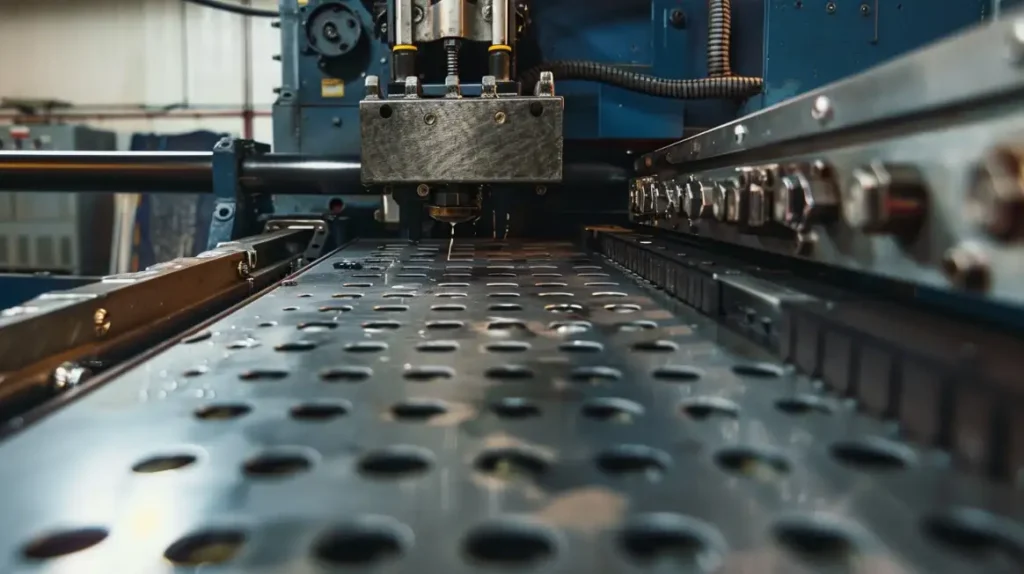
Key Performance Parameters
The performance of a punch press depends on several core factors. These values affect what the machine can do, how fast it works, and what kind of parts it can make.
Tonnage Capacity
Tonnage is the amount of force the machine can apply. It tells you how thick or hard the material can be before the press reaches its limit.
Lighter presses (20–50 tons) work well for thin sheets. Heavier presses (over 100 tons) are better for thicker materials or complex shapes. Using too much tonnage can damage tools. Too little may not cut cleanly.
Stroke Length and Speed
Stroke length is the distance the punch moves up and down. A longer stroke helps with deep drawing or forming taller parts. Shorter strokes are faster and suit flat punching jobs.
Stroke speed affects cycle time. Higher speeds mean more parts per hour. But too much speed can lead to heat buildup or tool wear. Many presses offer adjustable stroke speed for better control.
Shut Height
Shut height is the distance between the ram and the bed when the ram is fully down. It includes the thickness of the die set.
This value matters when choosing tooling. If the die is too tall for the shut height, it won’t fit. The shut height must be matched to the tooling and part shape.
Bed Size
The bed is the flat surface where the die rests. A larger bed allows more workspace for bigger parts or complex dies. Bed size also affects how easily parts move during automatic feeding.
Tooling Setup and Die Clearance
Tooling setup includes how easy it is to change or align dies. Fast-change systems reduce downtime between jobs.
Die clearance is the space between the punch and die edges. It must match the material thickness and type. Tight clearance gives cleaner cuts but wears tools faster. Too much clearance can cause rough edges or distortion.
Compatible Materials with Punch Press
Punch presses are suitable for a wide range of materials.
- Steel: This includes stainless steel, mild steel, and other types.
- Aluminum
- Brass
- Copper
Benefits of Using a Punch Press
A punch press is a practical tool for many fabrication shops. It boosts output, keeps quality steady, and handles different job sizes with ease.
High Productivity
Punch presses work fast. They can complete hundreds of strokes per minute. This makes them ideal for mass production.
Consistent Accuracy
Once set up, a punch press can repeat the same action over and over with tight tolerances. This repeatability is key when every part must match.
Versatile and Scalable
Punch presses handle many jobs—cutting, bending, shaping, and more. One machine can switch between operations with the right tooling.
Cost-Effective for Medium to Large Volumes
The upfront cost of a punch press and tooling pays off over time. Once setup is done, the cost per part drops quickly.
Challenges and Limitations
While punch presses offer many advantages, they also come with some drawbacks. Knowing these helps with planning and equipment selection.
Tooling Cost and Maintenance
Tooling for punch presses can be expensive, especially for custom shapes. Complex dies cost more and take time to produce. Tools also wear down over time. Regular sharpening and inspections are needed to keep the quality high.
Noise and Vibration
Mechanical punch presses make a lot of noise during operation. The impact between the punch and die creates loud, sharp sounds. This may require soundproofing, safety barriers, or hearing protection for operators.
Material Waste
Punching removes material to create holes or shapes. The leftover scrap can add up fast, especially in complex designs. Poor nesting or inefficient layouts waste even more material.
Limited to Sheet-Based Work
Punch presses only work with flat sheet metal. They can’t handle round stock, tubes, or pre-formed parts. If a project requires 3D shapes, deep draws, or structural components, other methods like CNC machining or press brakes may be needed.
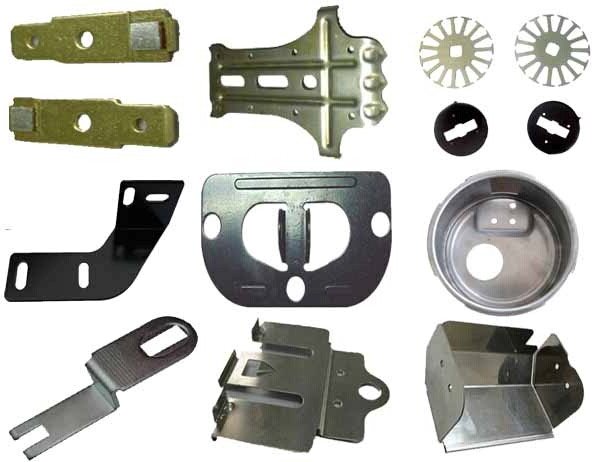
Applications Across Industries
Punch presses are used in many industries because they deliver fast, repeatable results. Their ability to produce custom shapes at scale makes them a go-to machine for many manufacturers.
Automotive Parts Manufacturing
Automakers use punch presses to cut and shape body panels, brackets, and reinforcements. These machines handle both small and large parts with tight tolerances.
Appliance and Consumer Goods
Punch presses help shape parts for washing machines, refrigerators, ovens, and HVAC units. Typical parts include control panels, frames, backplates, and structural supports.
Electrical Enclosures and Panels
Enclosures for power systems, routers, or switchgear need precise holes and cutouts. Punch presses can create vents, knockouts, and mounting slots in one cycle.
Aerospace and Defense Components
Aerospace and defense parts demand tight tolerances and high material strength. Punch presses are used to process aluminum and stainless steel sheets for aircraft panels, brackets, and covers.
Choosing the Right Punch Press for Your Needs
Selecting the right punch press depends on your shop’s goals, budget, and the parts you plan to make. A good match improves efficiency and reduces long-term costs.
Production Volume Considerations
For high-volume jobs, a mechanical punch press offers speed and reliability. It’s best for simple shapes and repeat production.
For low to medium volumes or complex parts, a hydraulic or servo-electric press gives better control and flexibility. These types also reduce wear on tools and lower setup time.
Automation features like tool changers or feeders help scale up when needed.
Material Type and Thickness
Thicker or harder materials need higher tonnage. Stainless steel or high-strength alloys require more force and stronger tooling.
If you work with aluminum or brass, you can use a lighter press with lower tonnage. The punch type and die clearance must still match the material to avoid defects.
Some presses allow easy adjustment of force and speed for different materials.
Budget and Space Requirements
Mechanical presses usually cost less upfront but can have higher operating noise and maintenance needs.
Hydraulic presses cost more but offer more flexibility and lower noise. Servo-electric types have the highest upfront cost but save money over time through energy efficiency and less maintenance.
Size matters too. A compact servo press fits small shops. Large-bed presses need more floor space and foundation support.
Maintenance and Support Availability
Some punch presses need regular oil changes, tool sharpening, or clutch adjustments. Others are lower maintenance but require specific training or software.
Choose a machine with local support, available parts, and clear manuals. Good vendor support helps avoid long downtimes.
Think long-term—easy maintenance can save time, reduce errors, and extend machine life.
Conclusion
A punch press is a machine that shapes sheet metal by pressing it with a punch and a die. It supports a wide range of operations like blanking, piercing, bending, and forming. With types like mechanical, hydraulic, and servo-electric, it fits various production needs—from simple parts to complex components.
Looking for a reliable solution for your punching or metal forming needs? Contact us now to get expert advice and a fast quote for your custom metal parts.
Hey, I'm Kevin Lee

For the past 10 years, I’ve been immersed in various forms of sheet metal fabrication, sharing cool insights here from my experiences across diverse workshops.
Get in touch

Kevin Lee
I have over ten years of professional experience in sheet metal fabrication, specializing in laser cutting, bending, welding, and surface treatment techniques. As the Technical Director at Shengen, I am committed to solving complex manufacturing challenges and driving innovation and quality in each project.

